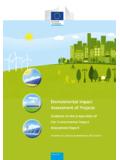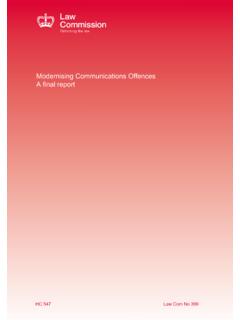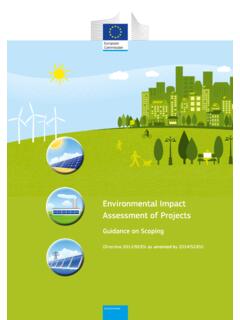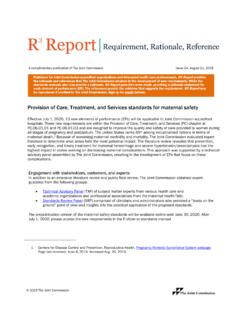Transcription of Resilience Systems Analysis Final - OECD
1 Guidelines for Resilience Systems AnalysisHow to analyse risk and build a roadmap to Resilience This work is published on the responsibility of the Secretary-General of the OECD. The opinions expressed and arguments employed herein do not necessarily reflect the official views of the Organisation or of the governments of its member countries. This document and any map included herein are without prejudice to the status of or sovereignty over any territory, to the delimitation of international frontiers and boundaries and to the name of any territory, city or area. Please cite this publication as: OECD (2014) Guidelines for Resilience Systems Analysis , OECD Publishing. Corrigenda to OECD publications may be found on line at: OECD 2014 You can copy, download or print OECD content for your own use, and you can include excerpts from OECD publications, databases and multimedia products in your own documents, presentations, blogs, websites and teaching materials, provided that suitable acknowledgment of the source and copyright owner is given.
2 All requests for public or commercial use and translation rights should be submitted to Requests for permission to photocopy portions of this material for public or commercial use shall be addressed directly to the Copyright Clearance Center (CCC) at or the Centre fran ais d'exploitation du droit de copie (CFC) at FOREWORD Resilience means that states can better withstand environmental, political, economic and social shocks and stresses. Bangladesh has become more resilient against floods as the government s ability to warn and evacuate people and control infectious diseases has improved. The recent peaceful democratic transitions in El Salvador, Malawi and Indonesia are signs of stronger societies. Angola, Ghana, Mozambique and others have set up natural resource stabilization funds and are less vulnerable to oil price shocks. Social capital, and the fact that host families support displaced families, have shown to help protect people from shocks and stresses in eastern Democratic Republic of Congo.
3 Resilience has been a key focus of the Organisation for Economic Co-operation and Development (OECD) since the financial crisis of 2008. The development and humanitarian communities also picked up on the concept, prompted by a ground-breaking 2011 review of the United Kingdom s humanitarian programme, and later as a better way to respond to major food emergencies in the Horn of Africa, and then in the Sahel. However, great ideas and political commitments mean little unless they have a real impact in the real world. A major scoping study by the OECD showed that numerous obstacles were preventing the concept of Resilience from translating into better development and humanitarian programming on the ground. The study found that field staff were cynical about the added value of Resilience . Some even saw Resilience as just a term to insert into proposals to help attract new funding. People also found it difficult to understand what Resilience actually meant.
4 Some narrowly interpreted Resilience as better food security and livelihoods planning, or just another way to look at disaster risk reduction. Such cynicism and confusion reinforced a feeling that Resilience was just another buzzword or fad , devoid of real meaning for programming. To counter this, OECD Development Assistance Committee members, together with other members of the Experts Group on Resilience , asked for specific technical guidance a simple how to guide that would allow people in the field to analyse what is needed to boost the Resilience of specific groups, specific Systems , and specific programmes, to the risks people face every day. The results of this Analysis are then used to design new programmes to boost Resilience , or to modify ongoing plans and actions. This guidance is the end result of that work. The guidance is aimed at professionals who are grappling with what Resilience actually means, and how to get key stakeholders to develop a shared vision of both the risks that exist in their particular context, and what to do about them; both now, and in the longer term.
5 We have called the outcome of the Analysis a roadmap to Resilience because it is just that a shared view of the way forward towards a more resilient future. The OECD will continue to support the Resilience roadmap process as it is rolled out in contexts prone to natural, climate, economic and/or geo-political shocks. Our members major humanitarian and development assistance providers will use this approach to re-think their programming through a risk lens. We will also support other organisations and states who seek to embed this approach into their programme design processes. I will watch this process with interest. Time has come for action and to show that Resilience Systems planning can have a real positive impact, on the real lives of real people! Erik Solheim Chair, Development Assistance Committee ACKNOWLEDGEMENTS This guidance has been prepared at the request of the OECD-led Experts Group on Risk and Resilience .
6 The process of developing and preparing the Resilience Systems Analysis was led by Rachel Scott, Senior Advisor, OECD under the overall guidance of Patti O Neil and Brenda Killen (OECD Development Co-operation Directorate). Andrew Mitchell and Astrid de Valon contributed significantly to the design and field testing of the methodology, and to the documentation of the guidelines. The methodology and the guidelines have been overseen by an Advisory Board of Experts, who have provided invaluable comments and contributions throughout the process, including: Alexandra Vogl (Asian Development Bank), Amanda Aspden (Australian Government Department for Foreign Affairs and Trade), Barbara Abbentheren (Deutsche Gesellschaft f r Internationale Zusammenarbeit GIZ), Dominque Albert and Roger Bellers (European Union Directorate-General for Humanitarian Aid and Civil Protection - ECHO), Luca Russo (Food and Agriculture Organisation of the United Nations), Marcus Oxley (Global Network of Civil Society Organisations for Disaster Reduction), Choe Chang (International Federation of Red Cross and Red Crescent Societies), Kimio Takeya (Japan International Cooperation Agency), Nadia Benani (Swiss Agency for Development and Cooperation), Anita Shah (United Kingdom Department for International Development), Daniel Maxwell (Tufts University), Maxx Dilley and Jo Scheuer (United Nations Development Programme)
7 , Kirsten Gelsdorf, Hansjoerg Strohmeyer and Andy Thow (United Nations Office for the Coordination of Humanitarian Affairs), Marc Gordon and Gillian Holmes (United Nations Office for Disaster Risk Reduction), and Hemang Karelia and Asbjorn Wee (World Bank). Particular thanks to Anita Shah for her thorough reading of the Final draft document. The methodology was first applied in eastern Democratic of Congo, an exercise that provided valuable practical insights on the use of the Resilience Systems Analysis tool. Special thanks go to Yannick Brand, Mia Jeong and Nona Zicherman of UNICEF, Democratic Republic of Congo, for hosting this process, and for their excellent insights on how to improve the design of the Analysis workshop and related processes. Thanks also go to all those people working and living in eastern Democratic Republic of Congo, who participated so enthusiastically in that Analysis process. Finally, our thanks to Australia and Japan, who provided the funding for this work, and to Beth del Bourgo, Stephanie Co c and Raundi Halvorson-Quevedo for their invaluable editorial advice and for the preparation of these guidelines for publication.
8 TABLE OF CONTENTS WHAT IS A Resilience SYSTEM Analysis ? .. 1 Why should we do a Resilience Systems Analysis ? .. 1 What is the added value of Resilience Systems Analysis , compared with risk management? .. 1 Who is involved in a Resilience Systems Analysis ? .. 2 How can we use the results of a Resilience Systems Analysis ? .. 2 What are the limits of Resilience Systems Analysis ? .. 3 Resilience SYSTEM Analysis : THE CONCEPTUAL FRAMEWORK .. 4 What is a Risk? What is a Shock? .. 5 What is a System? .. 5 What is Resilience ? .. 6 Resilience SYSTEM Analysis : A FOUR-STEP PROCESS .. 9 How long does a Resilience Systems Analysis take? .. 10 STEP 1 GOVERNANCE AND SCOPE .. 11 How do we define the scope of the Resilience Systems Analysis ? .. 11 What is critical for a successful Resilience Systems Analysis ? .. 12 How can we get the right stakeholders on board? .. 13 How can we ensure that people continue their support throughout the process? .. 13 Who should take the lead in organising a Resilience system Analysis ?
9 14 STEP 2 PRE- Analysis AND BRIEFING PACK .. 16 How do we build the briefing pack? .. 17 Action 1: Determine the scoping question .. 17 Action 2: Understand root risks and flow on effects to secondary risks .. 18 Action 3: Evaluate the probability that the root risks will occur .. 20 Action 4: Identify the key components of the system .. 21 Action 5: Analyse how each identified risk impacts each component of the system .. 23 Action 6: Determine overall severity of different risks on the system .. 24 What if we don t have all the right data? .. 24 Who should receive a copy of the briefing pack? .. 25 STEP 3 THE WORKSHOP .. 26 Why a Workshop? .. 26 Who should be invited to the workshop? .. 26 How is the two-day workshop structured? .. 27 Who should write the workshop report ? .. 29 Who should get a copy of the workshop report ? .. 29 STEP 4 USING THE ROADMAP TO BOOST Resilience .. 30 STEP 5 - MEASURING Resilience .. 33 System Resilience indicators .. 33 Negative Resilience indicators.
10 35 Process indicators .. 36 Output indicators .. 36 Proxy impact 37 BIBLIOGRAPHY .. i NOTES .. ii Index of tables Table 1: Examples of actions that could strengthen the capacities of livelihoods Systems (in different contexts) .. 8 Table 2: Categories of actors who should be involved in a Resilience Systems Analysis .. 14 Table 3: List of the ten risks analysed for the briefing pack in Eastern Democratic Republic of Congo .. 18 Table 4 : Example scales for probability of occurrence .. 20 Table 5: Example of a scale to assess impact .. 23 Table 6 : Outputs from Resilience Systems Analysis , and their 32 Index of figures Figure 1: Conceptual framework for the Resilience Systems Analysis .. 4 Figure 2: Examples of key livelihoods assets for household and communities in eastern Democratic Republic of Congo .. 6 Figure 3: The relationship between absorptive, adaptive and transformative capacities for strengthening Resilience .. 7 Figure 4: Resilience System Analysis : Four Main Steps.















